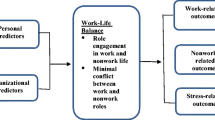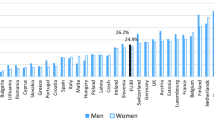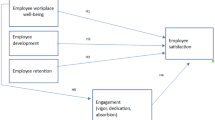Abstract
Employability, talent and/or motivation of people can be a source of sustainable competitive advantage; difficult for competitors to imitate. The involvement of people, and more specifically employee participation, has been identified as a key management tool to develop this advantage. Traditionally however, the industrial relations and personnel management streams have treated employee participation from different perspectives. Economic insights have guided the former, while how employees respond to the decisions in the workplace form the basis of the latter. Accordingly, three main employee participation practices are widely recognized in the field: employee management or decision-making, profit-sharing and employee share ownership. In this research, the relationship between 3 practices of participation, employee well-being and firm performance was explored in 278 Basque companies. Objective data was obtained for organizational performance measurement and 1503 employee responses were gathered about participation practices and well-being. After controlling company size and sector (manufacturing and services were tested in this study) the results showed a significant relationship between any form of participation and employee well-being. Interestingly, a significant and negative relationship was revealed for the relationship between employee decision-making participation and labor productivity. No statistical relationship was found between financial participation practices and organizational performance. This study, therefore, confirms the relationship between one of the pillars of HR practices and employee well-being, but fails to show that participation is positively related to higher firm performance (or vice versa). New research lines are opened for scientific contributors and important insights offered for managers.





Similar content being viewed by others
Notes
Eustat is the public body of the Basque Country that collects, analyses and publishes statistical information about every aspect of Basque Country.
Iberian Balance Sheet Analysis System (Sistema de Análisis de Balances Ibéricos) provides financial information corresponding to the annual balance sheets of more than 2 million Spanish companies.
References
Arando S et al (2015) Efficiency in employee-owned enterprises: an econometric case study of Mondragon. ILR Rev 68(2):398–425. https://doi.org/10.1177/0019793914564966
Bakan I et al (2004) The influence of financial participation and participation in decision-making on employee job attitudes. Int J Hum Resour Manag 15(3):587–616. https://doi.org/10.1080/0958515042000181142
Bakker AB, Demerouti E (2017) ‘Job demands–resources theory: taking stock and looking forward. J Occup Health Psychol. Bakker AB: Center of excellence for positive organizational psychology. Erasmus University Rotterdam, Rotterdam, pp 273–285. https://doi.org/10.1037/ocp0000056
Barney J (1991) Firm resources and sustained competitive advantage. J Manag 17(1):99–120. https://doi.org/10.1177/014920639101700108
Becker GS (2002) The age of human capital. Education in the twenty-first century
Becker GS (2008) Human capital: the concise encyclopedia of economics. Library of economics and liberty. https://www.econlib.org/library/Enc/HumanCapital.html
Beijer S et al (2019) The turn to employees in the measurement of human resource practices: a critical review and proposed way forward. Hum Resour Manag J. https://doi.org/10.1111/1748-8583.12229
Benson J, Brown M (2010) Employee voice: does union membership matter? Hum Resour Manag J 20(1):80–99
Blasi JR et al (2008) Creating a bigger pie? The effects of employee ownership, profit sharing, and stock options on workplace performance. Shared Capitalism at Work: Employee Ownership, Profit and Gain Sharing, and …, Cambridge. https://doi.org/10.3386/w14230
Blasi JR, Freeman R, Kruse D (2016) Do broad-based employee ownership, profit sharing and stock options help the best firms do even better? Br J Ind Relat 54(1):55–82. https://doi.org/10.1111/bjir.12135
Blau PM (1964) Exchange and power in social life. Wiley, New York
Bliese PD (2000) Within-group agreement, non-independence, and reliability: implications for data aggregation and analysis. Jossey-Bass, San Francisco
Boon C, DenHartog DN, Lepak DP (2019) A systematic review of human resource management systems and their measurement. J Manag 45(6):2498–2537. https://doi.org/10.1177/0149206318818718
Boselie P, Dietz G, Boon C (2005) Commonalities and contradictions in HRM and performance research. Hum Resour Manag J 15(3):67–94. https://doi.org/10.1111/j.1748-8583.2005.tb00154.x
Bowen DE, Ostroff C (2004) Understanding HRM–firm performance linkages: the role of the “strength” of the HRM system. Acad Manag Rev 29(2):203–221. https://doi.org/10.5465/amr.2004.12736076
Boxall P, Huo M-L (2019) The theory of high-performance work systems. In: Townsend K et al (eds) Elgar introduction to theories of human resources and employment relations. Edward Elgar Publishing, Cheltenham, pp 97–111
Boxall P, Macky K (2014) High-involvement work processes, work intensification and employee well-being. Work Employ Soc 28(6):963–984. https://doi.org/10.1177/0950017013512714
Boxall P, Purcell J (2016) Strategic HRM and sustained competitive advantage. Strategy and human resource management. Macmillan Education, Basingstoke, pp 82–103
Boxall P, Guthrie JP, Paauwe J (2016) Editorial introduction: progressing our understanding of the mediating variables linking HRM, employee well-being and organisational performance. Hum Resour Manag J 26(2):103–111. https://doi.org/10.1111/1748-8583.12104
Boxall P et al (2019) Chapter 1 high-involvement work processes and systems: a review of theory, distribution, outcomes, and tensions. In: Meng-Long H et al (eds) Research in personnel and human resources management. Emerald Publishing Limited, Bingley, pp 1–52. https://doi.org/10.1108/s0742-730120190000037002
Braam G, Poutsma E (2015) Broad-based financial participation plans and their impact on financial performance: evidence from a Dutch Longitudinal Panel. De Economist 163(2):177–202
Brown TA (2014) Confirmatory factor analysis for applied research. Guilford Publications, New York
Chang S-J, van Witteloostuijn A, Eden L (2010) From the editors: common method variance in international business research. J Int Bus Stud 41(2):178–184. https://doi.org/10.1057/jibs.2009.88
Conway E et al (2016) Demands or resources? The relationship between HR practices, employee engagement, and emotional exhaustion within a hybrid model of employment relations. Hum Resour Manag 55(5):901–917. https://doi.org/10.1002/hrm.21691
Cook JD et al (1981) The experience of work: A compendium andreview of 249 measures and their use. Harcourt Bracejovanovich, London
Cornelissen JP (2017) Preserving theoretical divergence in management research: why the explanatory potential of qualitative research should be harnessed rather than suppressed. J Manag Stud 54(3):368–383. https://doi.org/10.1111/joms.12210
Corning PA (1998) “The synergism hypothesis”: on the concept of synergy and its role in the evolution of complex systems. J Soc Evol Syst 21(2):133–172
Cronbach LJ (1951) Coefficient alpha and the internal structure of tests. Psychometrika 16(3):297–334
Cropanzano R, Mitchell MS (2005) Social exchange theory: an interdisciplinary review. J Manag 31(6):874–900. https://doi.org/10.1177/0149206305279602
Cropanzano R et al (2017) Social exchange theory: a critical review with theoretical remedies. Acad Manag Ann 11(1):479–516. https://doi.org/10.5465/annals.2015.0099
Cullinane N (2018) The field of employment relations: a review. In: Wilkinson A et al (eds) The Routledge companion to employment relations. Routledge, Abingdon, pp 23–36
Datta DK, Guthrie JP, Wright PM (2005) Human resource management and labor productivity: does industry matter? Acad Manag J 48(1):135–145. https://doi.org/10.5465/AMJ.2005.15993158
Delery JE, Roumpi D (2017) Strategic human resource management, human capital and competitive advantage: is the field going in circles? Hum Resour Manag J 27(1):1–21. https://doi.org/10.1111/1748-8583.12137
Den Hartog DN et al (2013) HRM, communication, satisfaction, and perceived performance: a cross-level test. J Manag 39(6):1637–1665
DeVellis RF (2003) Factor analysis. Scale development, theory and applications. Appl Soc Res Method Ser 26:10–137
Dube A, Freeman RB (2010) Complementarity of shared compensation and decision-making systems: evidence from the American labor market. In: Shared capitalism at work: employee ownership, profit and gain sharing, and broad-based stock options. University of Chicago Press, Chicago, pp 167–199
Dyer L, Reeves T (1995) Human resource strategies and firm performance: what do we know and where do we need to go? Int J Hum Resour Manag 6(3):656–670. https://doi.org/10.1080/09585199500000041
Elorza U, Aritzeta A, Ayestarán S (2011) Exploring the black box in Spanish firms: the effect of the actual and perceived system on employees’ commitment and organizational performance. Int J Hum Resour Manag 22(7):1401–1422
Elorza U et al (2016) The effect of management and employee perspectives of high-performance work systems on employees’ discretionary behaviour. Pers Rev 45(1):121–141
Eurofound (2013) European company survey, ECS. https://www.eurofound.europa.eu/surveys/european-company-surveys/european-company-survey-2013. Accessed 4 March 2019
Farndale E, Paauwe J (2018) SHRM and context: why firms want to be as different as legitimately possible. J Org Eff People Perform 5(3):202–210
Garmendia A (2019) Causality between high-involvement work systems, employee attitudes and organisational performance: a two-wave longitudinal study. Mondragon Unibertsitatea, Arrasate
Gavin MB, Mayer RC (2005) Trust in management and performance: who minds the shop while the employees watch the boss? Acad Manag J 48(5):874–888
George D, Mallery P (2016) IBM SPSS statistics 23 step by step: a simple guide and reference. Routledge, Abingdon
Gerhart B (2013) Research on human resources and effectiveness: some methodological challenges. In: HRM & performance: achievements & challenges. Wiley, Chichester, pp 149–171
Gerhart B et al (2000) Measurement error in research on human resources and firm performance: how much error is there and how does it influence effect size estimates? Pers Psychol 53(4):803–834. https://doi.org/10.1111/j.1744-6570.2000.tb02418.x
Gomez I, Uribetxebarria U, Gago M (2019) La participación de las personas trabajadoras en las empresas de Gipuzkoa y su situación respecto a Europa. In: Arregi A et al (eds) Participación de las personas trabajadoras en Gipuzkoa, pp 50–73. http://hdl.handle.net/20.500.11984/1563
Gouldner AW (1960) The norm of reciprocity: a preliminary statement. In: American sociological review. JSTOR, pp 161–178
Grant AM, Christianson MK, Price RH (2007) Happiness, health, or relationships? Managerial practices and employee well-being tradeoffs. Acad Manag Perspect 21(3):51–63. https://doi.org/10.5465/amp.2007.26421238
Guest DE (1997) Human resource management and performance: a review and research agenda. Int J Hum Resour Manag 8(3):263–276. https://doi.org/10.1080/095851997341630
Guest DE (2017) Human resource management and employee well-being: towards a new analytic framework. Hum Resour Manag J 27(1):22–38
Guthrie JP (2001) High-involvement work practices, turnover, and productivity: evidence from New Zealand. Acad Manag J 44(1):180–190
Han K, Kim A (2018) Differential impact of short-term and long-term group incentives. Empl Relat 40(3):549–564. https://doi.org/10.1108/ER-10-2016-0202
Huo M, Boxall P (2017) Lean production and the well-being of the frontline manager: the job demands–resources model as a diagnostic tool in Chinese manufacturing. Asia Pac J Hum Resour 55(3):280–297
Huselid MA (1995) The impact of human resource management practices on turnover, productivity, and corporate financial performance. Acad Manag J 38(3):635–672
Jackson SE, Schuler RS (1995) Understanding human resource management in the context of organizations and their environments. Annu Rev Psychol 46(1):237–264
James LR, Demaree RG, Wolf G (1993) r wg: an assessment of within-group interrater agreement. J Appl Psychol 78(2):306–309
Jiang K, Messersmith J (2017) On the shoulders of giants: a meta-review of strategic human resource management. Int J Hum Resour Manag 29(1):6–33. https://doi.org/10.1080/09585192.2017.1384930
Jiang Y et al (2015) Involvement work systems and operational effectiveness: exploring the moderating effect of national power distance. J Int Bus Stud 46(3):332–354. https://doi.org/10.1057/jibs.2014.61
Jones DC, Mygind N, Sen P (2019) Employee involvement, financial participation and firm performance. J Particip Empl Ownersh 1:1. https://doi.org/10.1108/jpeo-04-2018-0014
Kaufman BE (2014) The historical development of American HRM broadly viewed. Hum Resour Manag Rev 24(3):196–218
Kaufman BE (2015) Evolution of strategic HRM as seen through two founding books: a 30th anniversary perspective on development of the field. Hum Resour Manag 54(3):389–407. https://doi.org/10.1002/hrm.21720
Kehoe RR, Collins CJ (2017) Human resource management and unit performance in knowledge-intensive work. J Appl Psychol 102(8):1222–1236. https://doi.org/10.1037/apl0000216
Kehoe RR, Wright PM (2013) The impact of high-performance human resource practices on employees’ attitudes and behaviors. J Manag 39(2):366–391
Kim A, Han K (2019) All for one and one for all: a mechanism through which broad-based employee stock ownership and employee-perceived involvement practice create a productive workforce. Hum Resour Manag. https://doi.org/10.1002/hrm.21958
Klein KJ (1987) Employee stock ownership and employee attitudes: a test of three models. J Appl Psychol. https://doi.org/10.1037/0021-9010.72.2.319
Kloutsiniotis PV, Mihail DM (2019) Is it worth it? Linking perceived high-performance work systems and emotional exhaustion: the mediating role of job demands and job resources. Eur Manag J. https://doi.org/10.1016/j.emj.2019.12.012
Koziol W, Mikos A (2019) The measurement of human capital as an alternative method of job evaluation for purposes of remuneration. In: Central European journal of operations research. Springer, pp 1–11
Kruse D, Freeman R, Blasi J (2010) Shared capitalism at work: Employee ownership, profit and gain sharing, and broad-based stock options. University of Chicago Press, Chicago
Kurtulus FA, Kruse DL (2017) How did employee ownership firms weather the last two recessions? Employee ownership, employment stability, and firm survival: 1999–2011. WE Upjohn Institute, Kalamazoo
Larraza-Kintana M, Bayo-Moriones A (2009) Profit-sharing plans and affective commitment: does the context matter? Hum Resour Manag 48(2):207–226
Lawler EE (1986) High-involvement management. In: Participative strategies for improving organizational performance. ERIC
Lee Juil et al (2019) Enhancing employee creativity for a sustainable competitive advantage through perceived human resource management practices and trust in management. Sustainability 11(8):2305
McNeish D (2018) Thanks coefficient alpha, we’ll take it from here. Psychol Methods 23(3):412
Meyer JP, Allen NJ, Smith CA (1993) Commitment to organizations and occupations: extension and test of a three- component conceptualization. J Appl Psychol 78(4):538–551
Morgeson FP, Humphrey SE (2006) The work design questionnaire (WDQ): developing and validating a comprehensive measure for assessing job design and the nature of work. J Appl Psychol 91(6):1321–1339
Mullins F et al (2019) Broad-based employee stock ownership: what makes it effective in the management of human resources? Hum Resour Manag 58(6):567–570. https://doi.org/10.1002/hrm.21996
Noe RA et al (2017) Human resource management: gaining a competitive advantage. McGraw-Hill Education, New York
O’Boyle EH, Patel PC, Gonzalez-Mulé E (2016) Employee ownership and firm performance: a meta-analysis. Hum Resour Manag J 26(4):425–448. https://doi.org/10.1111/1748-8583.12115
Orlitzky M, Frenkel SJ (2005) Alternative pathways to high-performance workplaces. Int J Hum Resour Manag 16(8):1325–1348. https://doi.org/10.1080/09585190500220176
Paauwe J, Guest DE, Wright PM (2013) HRM and performance: achievements and challenges. Wiley, Hoboken
Park R, Kruse D (2014) Group incentives and financial performance: the moderating role of innovation. Hum Resour Manag J 24(1):77–94
Peccei R, Van De Voorde K (2016) The application of the multilevel paradigm in human resource management–outcomes research: taking stock and going forward. J Manag 45(2):786–818. https://doi.org/10.1177/0149206316673720
Peccei R, Van De Voorde K (2019) Human resource management–well-being–performance research revisited: past, present, and future. Hum Resour Manag J. https://doi.org/10.1111/1748-8583.12254
Peccei R et al (2013) HRM, well-being and performance: a theoretical and empirical review. In: Paauwe J, Guest DE, Wright PM (eds) HRM & performance: achievements & challenges. Wiley, Hoboken, pp 15–46
Peterson RA, Kim Y (2013) On the relationship between coefficient alpha and composite reliability. J Appl Psychol 98(1):194–198. https://doi.org/10.1037/a0030767
Poutsma E, Ligthart PE, Kaarsemaker E (2017) Employee ownership and high-performance work systems in context. In: Advances in the economic analysis of participatory and labor-managed firms, pp 5–22. https://doi.org/10.1108/s0885-33392016000017004
Prigogine I (1978) Time, structure, and fluctuations. Science 201(4358):777–785
Rafferty AE, Griffin MA (2006) Refining individualized consideration: distinguishing developmental leadership and supportive leadership. J Occup and Organ Psychol 79:37–61
Schuler RS, Jackson SE (1987) Linking competitive strategies with human resource management practices. Acad Manag Perspect 1(3):207–219
Subramony M (2009) A meta-analytic investigation of the relationship between HRM bundles and firm performance. Hum Resour Manag 48(5):745–768. https://doi.org/10.1002/hrm.20315
Tangen S (2005) Demystifying productivity and performance. Int J Product Perform Manag 54(1):34–46
Townsend K et al (2019) Theories used in employment relations and human resource management. In: Elgar introduction to theories of human resources and employment relations. Edward Elgar Publishing
van de Voorde K, Boxall P (2014) Individual well-being and performance at work in the wider context of strategic HRM. In: van Veldhoven M, Peccei R (eds) Well-being and performance at work. Psychology Press, Milton Park, pp 103–119
Van Veldhoven M et al (2019) Challenging the universality of job resources: why, when, and for whom are they beneficial? Appl Psychol. https://doi.org/10.1111/apps.12211
Vanhala S, Tuomi K (2006) HRM, company performance and employee well-being. Manag Revue 17(3):241–255
Williams M (2018) Understanding variation in the efficacy of financial participation across Europe: the role of country-level factors. Econ Ind Democr 39(2):195–227. https://doi.org/10.1177/0143831X15620846
Wood S (1999) Human resource management and performance. Int J Manag Rev 1(4):367–413. https://doi.org/10.1111/1468-2370.00020
Wood S, Ogbonnaya C (2018) High-involvement management, economic recession, well-being, and organizational performance. J Manag 44(8):3070–3095
Worthington RL, Whittaker TA (2006) Scale development research: a content analysis and recommendations for best practices. Couns Psychol 34(6):806–838
Wright PM, McMahan GC (1992) Theoretical perspectives for strategic human resource management. J Manag 18(2):295–320. https://doi.org/10.1177/014920639201800205
Wright PM, McMahan GC (2011) Exploring human capital: putting “human” back into strategic human resource management. Hum Resour Manag J 21(2):93–104. https://doi.org/10.1111/j.1748-8583.2010.00165.x
Wright P, Nishii L (2013) Strategic HRM and organizational behaviour: integrating multiple levels of analysis. In: Paauwe J, Guest DE, Wright PM (eds) HRM & performance: achievements & challenges. Wiley, Hoboken, pp 97–110
Wright PM, Ulrich MD (2017) A road well traveled: the past, present, and future journey of strategic human resource management. Ann Rev Organ Psychol Organ Behav 4(1):45–65. https://doi.org/10.1146/annurev-orgpsych-032516-113052
Acknowledgements
This research was supported with funds from the Gipuzkoako Foru Aldundia – Diputacion Foral de Gipuzkoa (a strategic collaboration agreement, between DFG and MU, part of the program called ‘Etorkizuna Eraikiz’). The views expressed in this manuscript are those of the authors and do not necessarily reflect those of the Gipuzkoako Foru Aldundia – Diputacion Foral de Gipuzkoa.
Author information
Authors and Affiliations
Corresponding author
Additional information
Publisher's Note
Springer Nature remains neutral with regard to jurisdictional claims in published maps and institutional affiliations.
Rights and permissions
About this article
Cite this article
Uribetxebarria, U., Garmendia, A. & Elorza, U. Does employee participation matter? An empirical study on the effects of participation on well-being and organizational performance. Cent Eur J Oper Res 29, 1397–1425 (2021). https://doi.org/10.1007/s10100-020-00704-7
Published:
Issue Date:
DOI: https://doi.org/10.1007/s10100-020-00704-7




